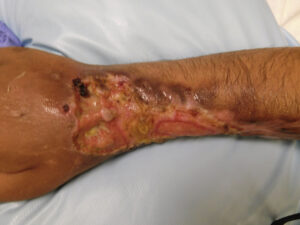A very Vile KroKodil
Dr Michelle Muscat
A homemade injectable desomorphine concoction goes by the street name krokodil,1 alternatively dubbed ‘Russian magic’. Desomorphine is an opiate derivative. Krokodil has also been referred to as ‘the drug that eats junkies’.2 This can be made for recreational purposes from a cocktail including ingredients obtained over the counter, notably codeine and other additives such as iodine, and red phosphorus from match striking surfaces. Given the illicit nature of the brews, it may have varied constituents and complexities in chemical composition with both different metabolites and contaminants.3 Drug addicts generally switch from heroin to krokodil due to financial reasons given that it is cheaper.4 In 2017 a study by Soares et al detected 54 morphinans which may potentially play a role in krokodil’s psychotropic action.5 Another analysis deemed that desomorphine is present as the major compound together with two other morphinans.6 It is best known as originating in Russia.7 It may cause skin necrosis8-10 as part of krokodil’s ‘nasty bite’ with the appearance similar to scaly discoloured ‘crocodile skin’.11 Osteonecrosis of the maxilla is common with krokodil.12-14 Fatal endomyocarditis has also been reported.15 Other effects include gangrene, ulceration and infection. There is a high mortality with its use.16-17 Although krokodil is generally injected intravenously, in 2016 Baquero et al reported a case where krokodil had been ingested orally.18 In recent years, experiments on rat models were carried out showing altered biochemistry, in keeping with its toxicity and probable oxidative stress which is caused. Biochemical findings showed changes in creatinine kinase and uric acid, as well as glutathione levels.19 Patterns of internet searches on the topic of this drug have also been studied. Infoveillance studies can be seen as novel approaches for the monitoring of illicit drug use.20-21

Source: Alessandra H et al. A new drug with a nasty bite: A case of krokodil-induced skin necrosis in an intravenous drug user. JAAD Case Rep Journal PMCID: PMC4864092. Reproduced with Permission.
References
- Heimer R. Patterns of new drug emergence: a comment in light of ‘krokodil’. The International journal on drug policy. 2013;24(4):275-7.
- Oliver T, Gheevarghese SJ, Gandhi U, Bhat ZY, Pillai U. “Krokodil”-a menace slowly spreading across the Atlantic. American journal of therapeutics. 2015;22(3):231-3.
- Neves JF, Alves EA, Soares JX, Cravo SM, Silva AM, Pereira Netto AD, et al. Data analysis of “krokodil” samples obtained by street-like synthesis. Data in brief. 2016;6:83-8.
- Alves EA, Grund JP, Afonso CM, Netto AD, Carvalho F, Dinis-Oliveira RJ. The harmful chemistry behind krokodil (desomorphine) synthesis and mechanisms of toxicity. Forensic science international. 2015;249:207-13.
- Soares JX, Alves EA, Silva AMN, de Figueiredo NG, Neves JF, Cravo SM, et al. Street-Like Synthesis of Krokodil Results in the Formation of an Enlarged Cluster of Known and New Morphinans. Chemical research in toxicology. 2017;30(8):1609-21.
- Alves EA, Soares JX, Afonso CM, Grund JC, Agonia AS, Cravo SM, et al. The harmful chemistry behind “krokodil”: Street-like synthesis and product analysis. Forensic science international. 2015;257:76-82.
- Shelton M, Ramirez-Fort MK, Lee KC, Ladizinski B. Krokodil: from Russia with love. JAMA dermatology. 2015;151(1):32.
- Haskin A, Kim N, Aguh C. A new drug with a nasty bite: A case of krokodil-induced skin necrosis in an intravenous drug user. JAAD case reports. 2016;2(2):174-6.
- Mullins ME, Schwarz ES. Commentary on “A new drug with a nasty bite: A case of krokodil-induced skin necrosis in an intravenous drug user”. JAAD case reports. 2016;2(5):418.
- Haskin A, Kim N, Aguh C. Reply to: “Commentary on ‘A new drug with a nasty bite: A case of krokodil-induced skin necrosis in an intravenous drug user'”. JAAD case reports. 2016;2(5):424.
- Grund JP, Latypov A, Harris M. Breaking worse: the emergence of krokodil and excessive injuries among people who inject drugs in Eurasia. The International journal on drug policy. 2013;24(4):265-74.
- Hakobyan K, Poghosyan Y, Kasyan A. The use of buccal fat pad in surgical treatment of ‘Krokodil’ drug-related osteonecrosis of maxilla. Journal of cranio-maxillo-facial surgery : official publication of the European Association for Cranio-Maxillo-Facial Surgery. 2018;46(5):831-6.
- Hakobyan K, Poghosyan Y. Spontaneous bone formation after mandible segmental resection in “krokodil” drug-related jaw osteonecrosis patient: case report. Oral and maxillofacial surgery. 2017;21(2):267-70.
- Poghosyan YM, Hakobyan KA, Poghosyan AY, Avetisyan EK. Surgical treatment of jaw osteonecrosis in “Krokodil” drug addicted patients. Journal of cranio-maxillo-facial surgery : official publication of the European Association for Cranio-Maxillo-Facial Surgery. 2014;42(8):1639-43.
- Sorrentino A, Trotta S, Colucci AP, Aventaggiato L, Marzullo A, Solarino B. Lethal endomyocarditis caused by chronic “Krokodil” intoxication. Forensic science, medicine, and pathology. 2018;14(2):229-35.
- Florez DHA, Dos Santos Moreira AM, da Silva PR, Brandao R, Borges MMC, de Santana FJM, et al. Desomorphine (Krokodil): An overview of its chemistry, pharmacology, metabolism, toxicology and analysis. Drug and alcohol dependence. 2017;173:59-68.
- Thekkemuriyi DV, John SG, Pillai U. ‘Krokodil’–a designer drug from across the Atlantic, with serious consequences. The American journal of medicine. 2014;127(3):e1-2.
- Baquero Escribano A, Beltran Negre MT, Calvo Orenga G, Carratala Monfort S, Arnau Peiro F, Meca Zapatero S, et al. Orally ingestion of krokodil in Spain: report of a case. Adicciones. 2016;28(4):242-5.
- Alves EA, Brandao P, Neves JF, Cravo SM, Soares JX, Grund JC, et al. Repeated subcutaneous administrations of krokodil causes skin necrosis and internal organs toxicity in Wistar rats: putative human implications. Human psychopharmacology. 2017;32(3).
- Zheluk A, Quinn C, Meylakhs P. Internet search and krokodil in the Russian Federation: an infoveillance study. Journal of medical Internet research. 2014;16(9):e212.
- Zheluk A, Quinn C, Meylakhs P. Metadata Correction: Internet Search and Krokodil in the Russian Federation: An Infoveillance Study. Journal of medical Internet research. 2015;17(3):e76.

